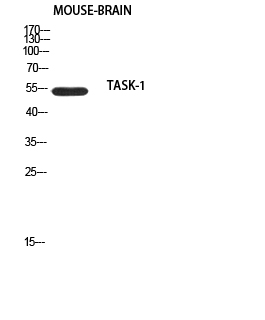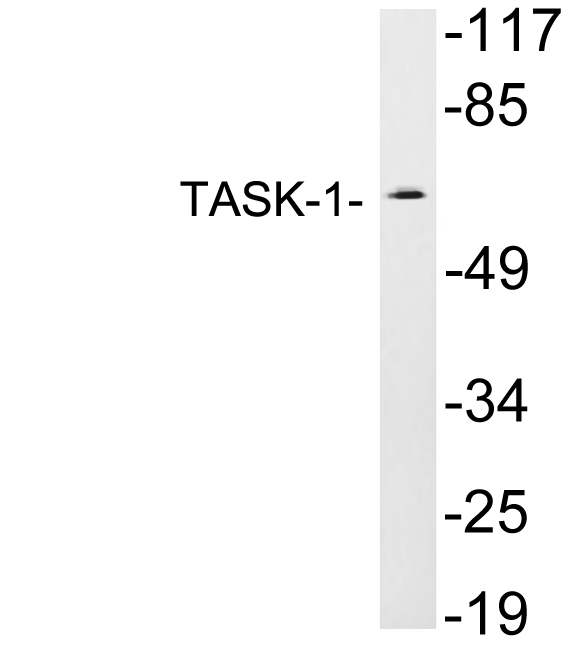TASK-1 Polyclonal Antibody
- Catalog No.:YT5689
- Applications:WB;ELISA
- Reactivity:Human;Mouse;Rat
- Target:
- TASK-1
- Fields:
- >>Aldosterone synthesis and secretion;>>Cortisol synthesis and secretion;>>Cushing syndrome
- Gene Name:
- KCNK3
- Protein Name:
- Potassium channel subfamily K member 3
- Human Gene Id:
- 3777
- Human Swiss Prot No:
- O14649
- Mouse Gene Id:
- 16527
- Mouse Swiss Prot No:
- O35111
- Rat Gene Id:
- 29553
- Rat Swiss Prot No:
- O54912
- Immunogen:
- The antiserum was produced against synthesized peptide derived from human TASK-1. AA range:47-96
- Specificity:
- TASK-1 Polyclonal Antibody detects endogenous levels of TASK-1 protein.
- Formulation:
- Liquid in PBS containing 50% glycerol, 0.5% BSA and 0.02% sodium azide.
- Source:
- Polyclonal, Rabbit,IgG
- Dilution:
- WB 1:500 - 1:2000. ELISA: 1:10000. Not yet tested in other applications.
- Purification:
- The antibody was affinity-purified from rabbit antiserum by affinity-chromatography using epitope-specific immunogen.
- Concentration:
- 1 mg/ml
- Storage Stability:
- -15°C to -25°C/1 year(Do not lower than -25°C)
- Other Name:
- KCNK3;TASK;TASK1;Potassium channel subfamily K member 3;Acid-sensitive potassium channel protein TASK-1;TWIK-related acid-sensitive K(+) channel 1;Two pore potassium channel KT3.1;Two pore K(+) channel KT3.1
- Observed Band(KD):
- 53kD
- Background:
- This gene encodes a member of the superfamily of potassium channel proteins that contain two pore-forming P domains. The encoded protein is an outwardly rectifying channel that is sensitive to changes in extracellular pH and is inhibited by extracellular acidification. Also referred to as an acid-sensitive potassium channel, it is activated by the anesthetics halothane and isoflurane. Although three transcripts are detected in northern blots, there is currently no sequence available to confirm transcript variants for this gene. [provided by RefSeq, Aug 2008],
- Function:
- function:pH-dependent, voltage-insensitive, background potassium channel protein. Rectification direction results from potassium ion concentration on either side of the membrane. Acts as an outward rectifier when external potassium concentration is low. When external potassium concentration is high, current is inward.,miscellaneous:Inhibited by external acidification. Activated by halothane and isoflurane.,similarity:Belongs to the two pore domain potassium channel (TC 1.A.1.8) family.,tissue specificity:Widespread expression in adult. Strongest expression in pancreas and placenta. Lower expression in brain, lung, prostate, heart, kidney, uterus, small intestine and colon.,
- Subcellular Location:
- Cell membrane ; Multi-pass membrane protein .
- Expression:
- Widespread expression in adult. Strongest expression in pancreas and placenta. Lower expression in brain, lung, prostate, heart, kidney, uterus, small intestine and colon.
- June 19-2018
- WESTERN IMMUNOBLOTTING PROTOCOL
- June 19-2018
- IMMUNOHISTOCHEMISTRY-PARAFFIN PROTOCOL
- June 19-2018
- IMMUNOFLUORESCENCE PROTOCOL
- September 08-2020
- FLOW-CYTOMEYRT-PROTOCOL
- May 20-2022
- Cell-Based ELISA│解您多样本WB检测之困扰
- July 13-2018
- CELL-BASED-ELISA-PROTOCOL-FOR-ACETYL-PROTEIN
- July 13-2018
- CELL-BASED-ELISA-PROTOCOL-FOR-PHOSPHO-PROTEIN
- July 13-2018
- Antibody-FAQs
- Products Images

- Western blot analysis of mouse-brain using TASK-1 antibody. Antibody was diluted at 1:500. Secondary antibody(catalog#:RS0002) was diluted at 1:20000

- Western blot analysis of lysates from JAR cells, using TASK-1 antibody.



